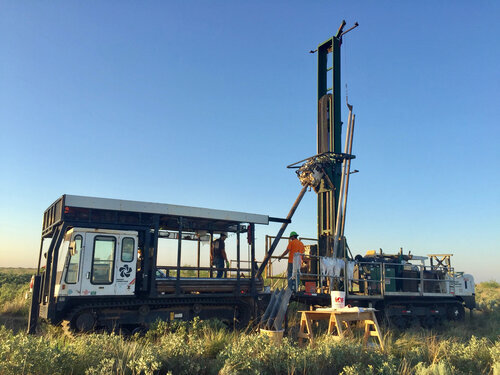FRAC SAND CORING
Physical sampling - in an attempt to identifying potential frac sand resources - initially begins with near-surface samples either gathered by hand (i.e. using a shovel or hand auger to get a few feet below surface) or with a back hoe. When collecting samples by hand, it is suggested to dig down at least 2-3 feet to obtain the cleanest sample with the least surface contamination.
Occasionally, Lonquist Frac Sand Services contracts out an auger rig to drill a “wildcat” hole with a single hollow-stem auger to better understand sand thickness. As necessary, split-spoon sampling techniques can be used to gather multiple in situ sand samples at different depths for sizing and quality assessment. Split-spoon sampling is a great option when gathering initial data in an area or operating with a limited budget.
Unfortunately, you do not gain the detailed understanding of changes in the sand resource and lithology that you do when gathering continuous cores. Additionally, you typically cannot capture enough sample to do extensive testing.
That being said, if the sampling interval can be minimized and a geologist can make detailed field observations, data may be sufficient to make initial frac sand resource in-place estimates.
FRAC SAND CORING
A comprehensive evaluation and quantity estimation of frac sand resources comes down to coring the prospective property using a sonic coring rig to collect continuous cores. Continuous cores provide a detailed look at the resource in place and are the first step to creating a detailed map of the frac sand resource.
Detailed field notes and photos can be used to construct stratigraphic columns for each core hole and are a valuable reference point when mining operations are underway. When frac sand coring - with a sonic coring rig - more than enough sample can be collected for detailed testing and equipment sizing analysis at different depth intervals.
OKLAHOMA FRAC SAND CORING TRACK-MOUNTED GEOPROBE SONIC CORING RIG
Usually, the cores are bagged in 2.5 to 10 foot intervals depending on changes in lithology. Frac sand lab testing at the Lonquist Frac Sand Lab can indicate which intervals yield enough product to support mining operations.
Initial sonic coring operations may be conducted at as much as 1/2-mile spacing. As areas of better frac sand resources are determined and initial pit locations begin to take shape, holes may be drilled on much tighter spacing (down to 500’-1,000’ apart).
Changes in lithology will also dictate tighter coring patterns to better understand the resource.
PERMIAN FRAC SAND CORING. TRACK-MOUNTED SONIC CORING RIG




